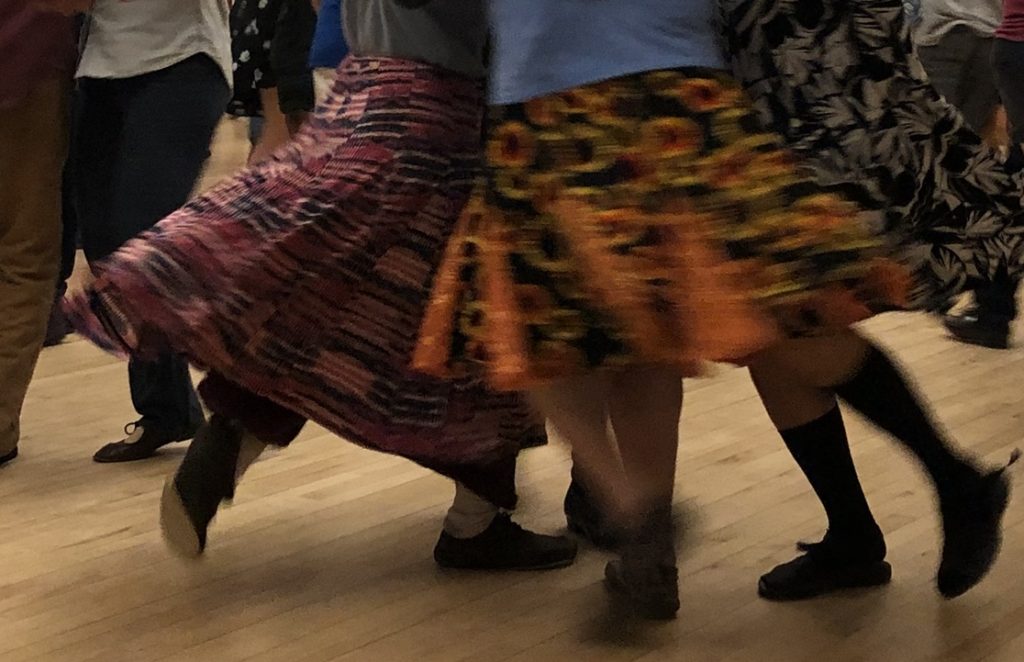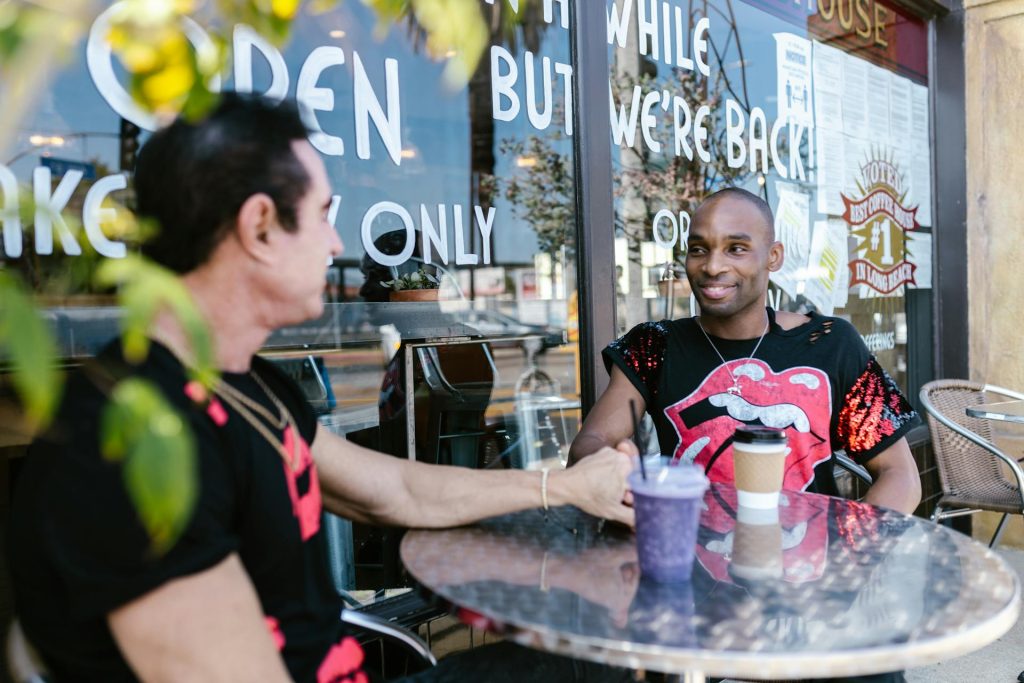Polyamory is having a moment in mainstream media, with the success of books like Miranda July’s All Fours and More: A Memoir of Open Marriage. But in queer circles, it’s been around, with a growing list of polyamory terms.
Many queer people feel that some form of non-monogamy works for their life. And there are many types of polyamory. It might be an open marriage after coming out later in life. Or it might be a polycule where multiple partners live together as a chosen family.

If you’re considering polyamory, don’t be put off by all the polyamory terms and meanings. Like the pride flags, there are a lot of them. But to find your place in the community, you’ll have to ask yourself what fits.
This ever-expanding polyamory glossary reflects a broad understanding of polyamorous life and how it intersects with societal norms and queer identities.
How’d we do? Did we get something wrong? Drop a comment or send us an email through our Contact page.
What’s the Meaning of Polyamory?
Polyamory
The practice of engaging in multiple romantic and/or sexual relationships with the consent and knowledge of all parties involved.
Compulsory Monogamy
The societal expectation or assumption that monogamy is the default or only acceptable form of relationship. People often feel pressured into monogamy, regardless of their actual desires or orientation.
Compulsory Heterosexuality
The societal assumption heterosexuality is the default sexual orientation. This idea often pushes people, especially women, into heterosexual relationships, even if that doesn’t align with their true identity.
Heteronormativity
The belief or assumption that heterosexuality, along with traditional gender roles, is the norm or default in society. This can marginalize or erase LGBTQ+ relationships and dynamics, including non-monogamous or polyamorous ones.
Queer Polyamory
Queer polyamory challenges both traditional heteronormative and monogamous expectations, offering space for diverse sexual and gender identities within polyamorous relationships.
Relationship Anarchy
A relationship style that rejects traditional rules or hierarchies, allowing each relationship to develop naturally without predefined structures like “primary” or “secondary.”
Hierarchical Polyamory
In hierarchical polyamory, relationships are ranked in terms of importance or priority. Typically, a primary relationship is the most central, often involving shared living arrangements, financial entanglement, or long-term commitment. Secondary or tertiary relationships are considered less central, with fewer entanglements or expectations. Hierarchical polyamory allows individuals to prioritize certain partners while still engaging in multiple relationships.
Hierarchical polyamory can be considered controversial in many poly circles. Many see hierarchy itself as devaluing and dehumanizing partners besides the primary.
Ethical Nonmonogamy (ENM)
Ethical nonmonogamy refers to any type of non-monogamous relationship in which all parties involved are aware of, and consent to, the non-exclusive nature of the relationships. ENM emphasizes honesty, transparency, and mutual respect. This term is broad and can encompass polyamory, open relationships, swinging, and other forms of consensual non-monogamy. The key is that all parties have an understanding and agreement about the relationship structure.
The term “ethical” is also considered controversial among may poly people, as it implies “nonmonogamy” is not inherently ethical.
Poly Relationship Styles and Roles
Metamour
A partner’s partner with whom one is not romantically involved. For example, if you’re dating someone who’s also dating someone else, that other person is your metamour.

Closed Polyamory
A poly dynamic where all members agree not to engage with new partners outside the existing group, creating a closed network.
Open Polyamory
A poly setup where people are free to seek additional relationships or partners outside their current circle, with consent and communication.
Primary Relationship
The central or most committed relationship in a polyamorous dynamic. Not all poly relationships have a primary partner, but for some, it signifies a main, life-sharing bond.
Secondary Relationship
A less central relationship in a poly dynamic, often involving less entanglement in areas like living arrangements or finances.
Triad
A polyamorous relationship involving three people, all of whom are romantically involved with each other.
Quad
A relationship dynamic where four people are involved in romantic relationships with one another in some capacity.
Vee (V or Hinge Relationship)
A relationship where one person (the hinge or pivot) is romantically involved with two others, but those two people are not romantically involved with each other.
Polyfidelity
A type of polyamorous relationship where all members are committed to only dating or having sexual relationships with each other, much like a closed relationship.
Kitchen Table Polyamory
A poly dynamic where all partners, including metamours, have a close, often friendly relationship, to the point where they might comfortably sit around the kitchen table together.
Parallel Polyamory
A polyamorous setup where partners prefer to keep their relationships with others more separate. Metamours may not have any significant interaction with each other.
Solo Polyamory
A polyamorous individual who values their independence and does not prioritize primary or nested relationships. They may have multiple relationships but choose not to live with or share life structures with any partner.
Polycule
A term used to describe a network of connected relationships in a polyamorous group. It can include all partners and metamours, visualizing how everyone is connected romantically.
Nesting partner
A nesting partner is a person with whom you share a home or cohabitate in a polyamorous relationship. This term emphasizes the logistical or domestic aspect of the relationship, indicating that partners live together and may share responsibilities like finances, household duties, parenting, or caregiving, but it doesn’t necessarily imply a primary or hierarchical relationship dynamic.
All the Feels
New Relationship Energy (NRE)
The intense, exciting emotions that come with the beginning of a new romantic relationship. NRE is often discussed in poly circles as it can affect existing relationships.
Compersion
The feeling of happiness one experiences when their partner finds joy or love with someone else, often described as the opposite of jealousy.
Jealousy
A common emotional experience in polyamory, but often viewed as something to be managed through communication and personal growth, rather than avoided or suppressed.
Negotiation
The process of discussing and agreeing on boundaries, expectations, and dynamics within polyamorous relationships. It’s a key aspect of maintaining transparency and consent.
Boundaries
The personal limits set by individuals within polyamorous relationships to ensure everyone’s comfort, safety, and respect. These can include emotional, physical, or logistical boundaries.
Many poly people will carefully distinguish “boundaries” from “ultimatums.” A “boundary” is a limitation you set for yourself, ie “I will not date someone who is not out to their family.” On the other hand, an “ultimatum” is making demands of a partner, ie “If you don’t come out to your family, I’m breaking up with you.” Many see ultimatums as unethical, especially if they attempt to exert control or ownership of a partner.
Honey Don’t Review: A Raw, Slutty Package of B-Movie Goodness
A year and a half after the movie studio marketers insisted on misnaming Drive-Away Dolls,…
What Does LGBTQ Stand For? Joining the Alphabet Mafia
Since the very start, it’s been a target of mockery. The acronym LGBTQIA+ comes out…
Is Living Apart Together Queer?
When we talk about queering relationships, we’re only talking a little about sexuality. We’re also…
My Old Ass Review: Holy Shit, This Worked!
My Old Ass is two different movies, depending on how old you are. If you’re…
Polyamory Terms: A Glossary for Newly-Out Queer Folx
Polyamory is having a moment in mainstream media, with the success of books like Miranda…
Queer Polyamory: Dance ‘Til They’re Not a Stranger
There are a lot of misconceptions about polyamory – much less queer polyamory. We get…








